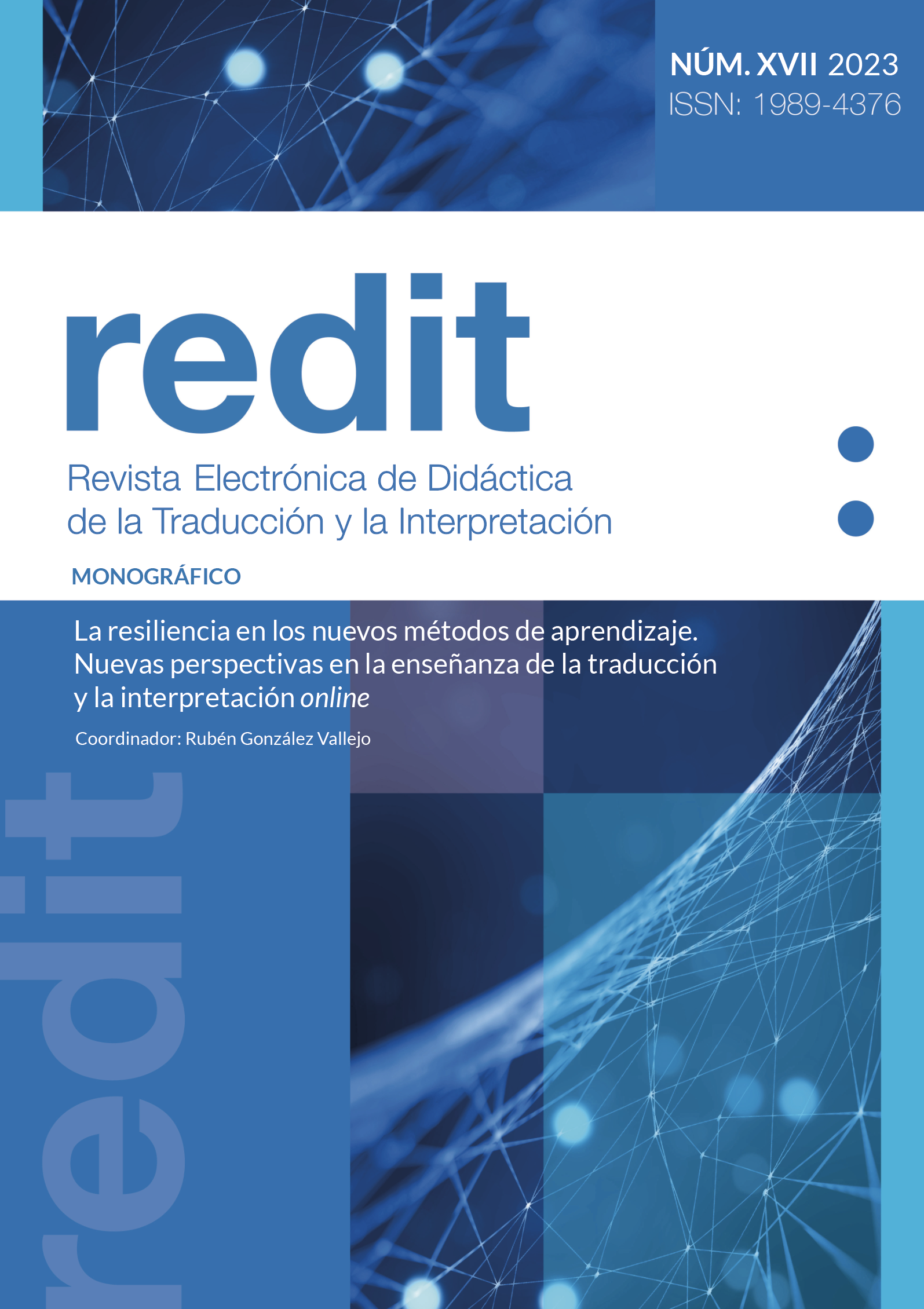Stressors derived from remote simultaneous interpretation: the discussion forum as an identification tool for training
DOI:
https://doi.org/10.24310/redit.17.2023.18302Keywords:
Remote Simultaneous Interpreting, discussion forum, quality in interpreting, interpreting trainingAbstract
Remote Simultaneous Interpreting has become an indispensable tool in the wake of the pandemic, raising a number of questions for interpreting practice and training.In order to identify the professional issues of concern to trainee interpreters, a discussion forum was held focusing on the training preparation of students and their suitability for the current professional context.Among the results, concerns about privacy, technical difficulties, loss of information due to the absence of non-verbal language and limitations due to distance between co-workers stand out. This underlines the need to explore what new training needs must be covered in the face of a professional context full of new challenges.
Downloads
Metrics
References
Baigorri Jalón, J. 2004. La interpretación de conferencias. El nacimiento de una profesión. Granada: Editorial Comares.
Brisau, A., R. Godijns y C. Meuleman 1994. “Towards a Psycholinguistic Profile of the Interpreter”. En Meta, 39(1): 87-94. [consulta: 15 de julio de 2023]
Chiang, Y. N. 2010. “Foreign Language Anxiety and Student Interpreters’ Learning Outcomes: Implications for the Theory and Measurement of Interpretation Learning Anxiety”. En Meta, 55(3): 589-601. [consulta: 15 de julio de 2023]
El-Metwally, M. 2021. “A brief introduction to remote interpreting platforms”. En el congreso Innovation in Interpreting Summit.
García Becerra, O. 2012. La incidencia de las primeras impresiones en la evaluación de la calidad de la interpretación simultánea: un estudio empírico. Tesis doctoral. Granada: Universidad de Granada.
Grice, H. P. 1975. “Logic and Conversation”. En Cole and Morgan. (eds.) Syntax and Semantics, New York: Academic Press, 41-58. [consulta: 10 de julio de 2023]
Jiménez Serrano, O. 2022. “Early studies indicate that the bulk of interpreting has shifted to remote”. En CLINA, 7(1): 43-55. [consulta: 15 de julio de 2023]
Jiménez Serrano, O. 2019. “Foto fija de la interpretación simultánea remota al inicio del 2020”. En Revista Tradumàtica. Tecnologies de la Traducció, 17: 59-80. [consulta: 10 de julio de 2023]
Kilian G., L. Keller, R. Amos y S. Hengl 2019. “Expectations vs. experience: Attitudes towards video remote conference interpreting”. En Interpreting, 21(2): 270-304. [consulta: 15 de julio de 2023]
Korpal, P. 2016. “Interpreting as a stressful activity: Physiological measures of stress in simultaneous interpreting”. En Poznan Studies in Contemporary Linguistics, 52(2): 297-316. [consulta: 7 de julio de 2023]
Krueger, R. A. 2014. Focus groups. A practical guide for applied research. Thousand Oaks: Sage publications.
Lázaro Gutiérrez, R. y A. Nevado 2022. “Remote Interpreting in Spain after the Irruption of COVID-19: A Mapping Exercise”. En Hikma, 21: 211-230. [consulta: 18 de julio de 2023]
Mahyub Rayáa, B. 2023. “La calidad de la interpretación simultánea remota según usuarios e intérpretes árabe-español”, en Bourne, J. et al. (eds), Reflexiones sobre ética profesional de traductores e intérpretes y buenas prácticas. Nuevos contextos en la profesión y en la formación, Granada: Comares.
Moser-Mercer, B. 2005. “Remote interpreting: The crucial role of presence”. En Bulletin Suisse de linguistique appliquée, 81: 73-97. [consulta: 20 de julio de 2023]
Moya-Albiol, L. y A. Salvador 2001. “Empleo de estresores psicológicos de laboratorio en el estudio de la respuesta psicofisiológica al estrés”. En Anales de Psicología / Annals of Psychology, 17(1): 69-81. [consulta: 5 de julio de 2023]
Pedraz Marcos, A., M. Zarco Colón, M. Ramasco Gutiérrez y A. M. Palmar Santos 2014. Investigación Cualitativa. Barcelona: Elsevier.
Poyatos, F. 1994. La comunicación no verbal I: Cultura, lenguaje y comunicación. Madrid: Istmo.
Poyatos, F. 1994. La comunicación no verbal II: Paralenguaje, kinésica e interacción. Madrid: Istmo.
Rodríguez G. y E. García, 1996. Metodología de la investigación cualitativa. Málaga: Aljibe.
Rojo López, A., A. Foulquié-Rubio, L. Espín López y F. Martínez Sánchez 2021. “Analysis of speech rhythm and heart rate as indicators of stress on student interpreters”. En Perspectives, 29(4): 591-607. [consulta: 20 de julio de 2023]
Rusko, T. 2011. “Some Aspects of “Face-Saving” in Dialogue Discourse”. En Santalka, 19(1): 94-101. [consulta: 23 de julio de 2023]
Haro Soler, M. D. M. 2019. “Autoconfianza versus autoeficacia del traductor: propuesta terminológica y estado de la cuestión”. En Cadernos de Tradução, 39(2): 204-226. [consulta: 5 de agosto de 2023]
Vigier-Moreno, F. J. y R. Lázaro Gutiérrez 2019. “La formación en interpretación remota: una experiencia docente interuniversitaria”. En Innovación Educativa, 29: 141-156. [consulta: 5 de julio de 2023]
Downloads
Published
How to Cite
Issue
Section
License

Este obra está bajo una licencia de Creative Commons Reconocimiento-NoComercial-SinObraDerivada 4.0 Internacional.






29.png)
